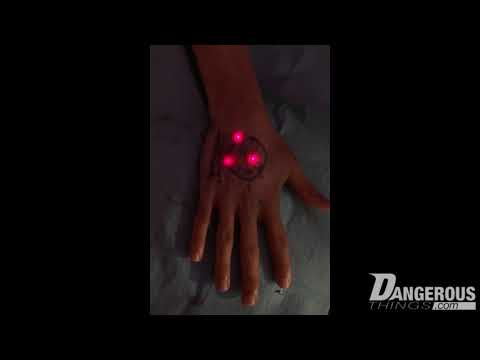It seems the ghost of flexNExT lives on, and we are regularly getting inquiries as to when it will be back in stock or why it was discontinued or when it will be re-engineered. In short, we had almost all flexNExT implants experience some sort of electronics failure. None of the coatings were compromised, and there were no safety issues involved in the failure, they just simply had parts stop working. Here’s what happened..
Chip failures
The flexNExT contained an NFC inlay from Smatrac called Bullseye. This inlay was made like most wet inlays are - by securing the NFC chip to an ink based antenna printed on to a flexible substrate of PET plastic. The chip is secured using a process called flip-chip, which is basically gluing the chip face down on to the antenna pads using special conductive glue. The connection is brittle and nowhere near as strong as soldering two things together. The flexibility of the inlay PET substrate is deceiving, because this thing is not designed to flex much at all. Somewhere between a few weeks to a few months, the small but constant movements and undulations decouple the chip from the substrate and the NFC portion of the flexNExT effectively dies.
LED failures
The LEDs we added to the flexNExT were actually just small self-contained LED modules, typically used on fingernails (NFC Nails). These were small copper antenna coils etched into flex PCB polyamide substrates with some passive components on board along with an LED. In theory these soldered connections should have been much stronger and more well suited for the nature of a flexible implant like the flexNExT, however there were two things that caused the LED modules to regularly fail.
The first issue was that the small surface mount passive components were not placed and soldered by machine, they were placed and soldered by hand.. which is extremely difficult work to do under a microscope. The quality of the placement and soldering was routinely terrible.. just barely good enough to work in most cases. This is fine if all you are doing is securing these things to a fingernail and covering them with acrylic nail polish.. but putting them into a device like the flexNExT where small movements, twists, and bends are constantly happening.. it ends up breaking those fragile hand soldered connections.
The second issue was that because of the height of these components on the flex PCB, we needed to apply a resin coating overtop of them to make the encapsulation process using our special biopolymer deposit a uniformly thick layer of polymer overtop of the flexNExT. The idea was that aside from providing a nice smooth transition along the z-axis, creating a dome shape over the components, that the resin would also protect these components and help stop the connections from breaking off the PCB. In actuality, the opposite happened.. the resin gripped the components very well, but did not stick to the flex PCB at all, turning the resin itself into a giant lever that easily ripped the components off the board when hardly any pressure or bend was introduced to the module PCB.
Re-engineering the flexNExT
For these reasons, we have discontinued the flexNExT and we are exploring ways to re-engineer it. The idea we want to explore is to begin integrating or own LEDs into our own flex PCB designs which we produce ourselves. This controls placement and quality of the SMT component connections to the PCB, and we can integrate the antennas so the chip and LEDs are sharing the same antenna coil. The other thing we are exploring is new resins that are flexible and adhere well to both the PCB as well as the components.
The important thing to understand is that our R&D process is slow and sometimes meandering.. since the goals we want to accomplish involve many new steps and discoveries which must be made along the way, even to achieve something as simple as putting LEDs on to a flex PCB. In short, we have no ETA for a re-engineered flexNExT implant.. it is something we are taking in small steps as we solve the various problems involved.
